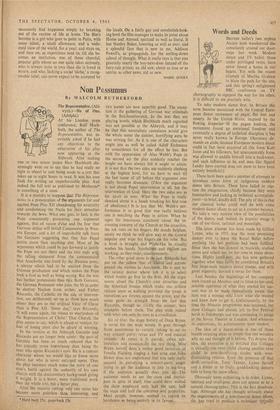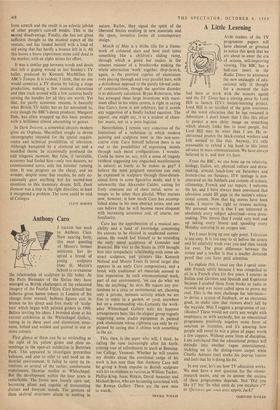Words and Deeds
To take modern dance first. In Britain this term became associated with the Central Euro- pean dance movement of angst, flat feet and misery. In the United States, inspired by the flowing draperies of the pagan Isadora, the movement found an emotional freedom and eventually a degree of technical discipline it has never really known in Europe. (Accuracy de- mands an aside, because European modern dance could in fact have acquired all this from Kurt Jooss and his followers, but unaccountably Jooss was allowed to paddle himself info a backwater, and such influence as he and men like Sigurd Leeder have exerted does not seem to have been entirely beneficial.) There have been quite a number of attempts to introduce some form of indigenous modern dance into Britain. These have Jailed to cap- ture the imagination, chiefly because they were humourless and lacking in technical accomplish- ment—in brief, deadly dull. The pity of this is that our classical ballet could well do with some modern dance idiom to act as a counter-balance. We take a very narrow view of the possibilities Of the dance, and, indeed, its popular image is one of toe-shoes, tarlatan and moonlight.
The latest attempt has been made bY Gillian Lynne, who in 1951 was the most promising dancer ever to leave the Royal Ballet before anything like her promise had been fulfilled. Since then she has danced in musicals, studied mime and struck out on her own in many direc- tions. Highly intelligent, she has now gathered together what may, fairly be considered Britain's first large-scale modern dance troupe, and with great ingenuity devised a revue for them.
Last Sunday the beginnings of her company were traced on Monitor, and to listen to her cool, ,sensible appraisal of what they needed for suc- cess was to be made immediately aware that here was a woman who knew what she wanted and knew how to get it. Unfortunately, by the time the Monitor programme was screened, her show Collages had already left its first Festival berth in Edinburgh and was continuing its pangs at the Savoy Theatre in London. And whatever its aspirations, its achievements were modest.
The idea of a dance-revue is one of those breath-stopping ideas so simple that one wonders why no one thought of it before. Yet despite the idea, the execution is so botched that Collages is virtually one twee cliehd chasing another twee clichd in ever-decreasing circles with ever- , diminishing returns. Even the presence of that droll comedian, Tony Tanner, Lynne herself and a dozen or so lively, good-looking dancers fails to keep the show afloat.
Obviously some rethinking is in order. Lynne, talented and intelligent, does not appear to be a natural choreographer. This is the first disadvan- tage. Although she has thought seriously about the requirements of a non-classical dance idiom, she has tried to produce a technique v,irtnally from scratch and the result is an eclectic job-lot of other people's cast-off modes. This is the second disadvantage. Finally, she has not given sufficient thought to the musical aspect of the venture, and has landed herself with a load of old swing that has hardly a bounce left in it. All this leaves a brave experiment stone cold dead in the market, with an alpha minus for effort.
It was a similar gap between words and deeds that left a gaping wound in last Sunday's TV ballet, produced by Kenneth MacMillan for ABC's Tempo. It is evident, I think, that no one would construct a TV drama by taking a stage production, making a few minimal alterations and then track around with a few cameras busily turning the handles for all they are worth. Yet that, for partly economic reasons, is basically what British TV ballet has so far amounted to, even though the BBC's dance producer, Margaret Dale, has often wrapped up this basic product with a brilliance almost amounting to genius.
In Dark Descent, a somewhat obscure modern gloss on Orpheus, Macmillan sought to devise choreography intended for the spatial require- ments and technical possibilities of television. Although hampered by a cluttered set and a muddled theme, he occasionally produced the odd telegenic moment. But false, if inevitable, economy had fooled him—only two dancers, no commissioned score, only ten minutes' running time. It was progress on the cheap, and no wonder, despite some fine touches, he only oc- casionally gave anything but his second-best invention to this transitory dream. Still, Dark Descent was a step in the right direction; at least it recognised a problem. The same could be said of Collages.
CLIVE BARNES











































 Previous page
Previous page